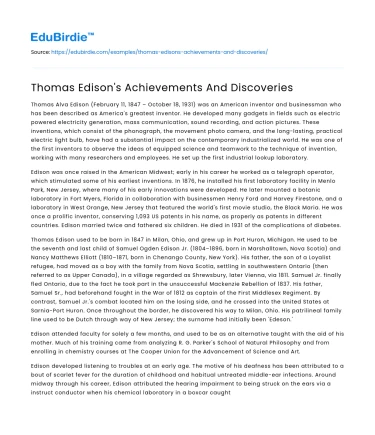Thomas Alva Edison (February 11, 1847 – October 18, 1931) was an American inventor and businessman who has been described as America's greatest inventor. He developed many gadgets in fields such as electric powered electricity generation, mass communication, sound recording, and action pictures. These inventions, which consist of the phonograph, the movement photo camera, and the long-lasting, practical electric light bulb, have had a substantial impact on the contemporary industrialized world. He was one of the first inventors to observe the ideas of equipped science and teamwork to the technique of invention, working with many researchers and employees. He set up the first industrial lookup laboratory.
Edison was once raised in the American Midwest; early in his career he worked as a telegraph operator, which stimulated some of his earliest inventions. In 1876, he installed his first laboratory facility in Menlo Park, New Jersey, where many of his early innovations were developed. He later mounted a botanic laboratory in Fort Myers, Florida in collaboration with businessmen Henry Ford and Harvey Firestone, and a laboratory in West Orange, New Jersey that featured the world's first movie studio, the Black Maria. He was once a prolific inventor, conserving 1,093 US patents in his name, as properly as patents in different countries. Edison married twice and fathered six children. He died in 1931 of the complications of diabetes.
Save your time!
We can take care of your essay
- Proper editing and formatting
- Free revision, title page, and bibliography
- Flexible prices and money-back guarantee
Thomas Edison used to be born in 1847 in Milan, Ohio, and grew up in Port Huron, Michigan. He used to be the seventh and last child of Samuel Ogden Edison Jr. (1804–1896, born in Marshalltown, Nova Scotia) and Nancy Matthews Elliott (1810–1871, born in Chenango County, New York). His father, the son of a Loyalist refugee, had moved as a boy with the family from Nova Scotia, settling in southwestern Ontario (then referred to as Upper Canada), in a village regarded as Shrewsbury, later Vienna, via 1811. Samuel Jr. finally fled Ontario, due to the fact he took part in the unsuccessful Mackenzie Rebellion of 1837. His father, Samuel Sr., had beforehand fought in the War of 1812 as captain of the First Middlesex Regiment. By contrast, Samuel Jr.'s combat located him on the losing side, and he crossed into the United States at Sarnia-Port Huron. Once throughout the border, he discovered his way to Milan, Ohio. His patrilineal family line used to be Dutch through way of New Jersey; the surname had initially been 'Edeson.'
Edison attended faculty for solely a few months, and used to be as an alternative taught with the aid of his mother. Much of his training came from analyzing R. G. Parker's School of Natural Philosophy and from enrolling in chemistry courses at The Cooper Union for the Advancement of Science and Art.
Edison developed listening to troubles at an early age. The motive of his deafness has been attributed to a bout of scarlet fever for the duration of childhood and habitual untreated middle-ear infections. Around midway through his career, Edison attributed the hearing impairment to being struck on the ears via a instruct conductor when his chemical laboratory in a boxcar caught hearth and he was once thrown off the instruct in Smiths Creek, Michigan, alongside with his apparatus and chemicals. In his later years, he modified the story to say the damage happened when the conductor, in supporting him onto a transferring train, lifted him by means of the ears. Being absolutely deaf in one ear and barely hearing in the other, Edison would hear to a music participant or piano by using chomping into the wood to take in the sound waves into his skull. The waves would then omit thru the cochlea and into the auditory nerve and in the end into his brain. Due to this method of listening, he could now not stand vocal vibrato nor hear at the very best frequencies.






 Stuck on your essay?
Stuck on your essay?

